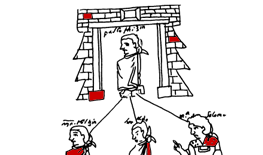 |
|
 |
 |
main | classes | cv | dissertation | news |
|
dissertation |
|
|
|
During the first one hundred years of Spanish rule in Central Mexico, Nahua people created a corpus of colorful pictorials showing conventionalized representations of men and women linked to each other into genealogical networks. Of the nearly eighty extant examples of these Nahua pictorial genealogies, more than a third come from the small region of Tlaxcala in Eastern Central Mexico. These Tlaxcalan pictorials together represent the only subgroup within the larger genre of Nahua pictorial genealogies that exhibits iconographic and compositional consistency. This dissertation seeks to explain why the people of Tlaxcala produced so many genealogies and why these pictorials are formally coherent. The pictorial genealogies of Tlaxcala are analyzed within their early colonial context and with a consideration of their pre-Columbian roots, using primary and secondary sources in Nahuatl and Spanish. Legal transcripts created in conjunction with a full third of the Tlaxcalan genealogies reveal that, following native tradition, the images functioned as evidentiary pictorials presented in disputes between native citizens over land. These and other textual sources on local social history hint at an elite class of locals accustomed to claiming noble status on the basis of their positions within the teccalli, a distinctive system of social organization that was historically unique to the region. The formal consistency of the Tlaxcalan genealogies reflects an unusually cohesive sense of corporate identity that emerged from the teccalli system. This study finds that during the first one hundred years of Spanish rule, the elite citizens of Tlaxcala were particularly empowered by this solid sense of identity to react to shifting dynamics in their colonial environment. In the genealogy, Tlaxcalan people found a powerful instrument through which to reinforce their noble identity and negotiate their social and political positions in a changing world. The widespread use of this pictorial genre among local nobility helped to establish Tlaxcala as a hub of genealogical production. As an appendix, the dissertation includes an annotated catalogue of pictorial genealogies from early colonial Tlaxcala, as well as another that lists examples of the genre from the larger Nahua region of Central Mexico. |
|